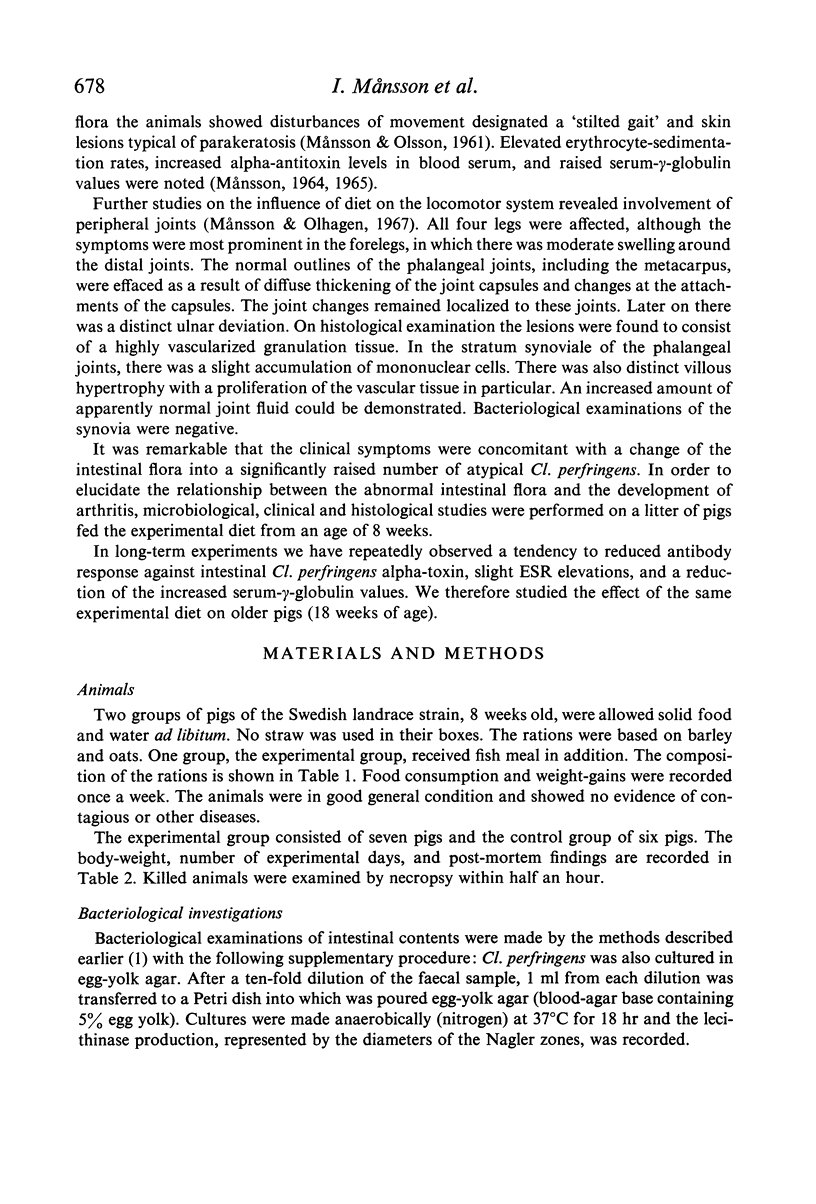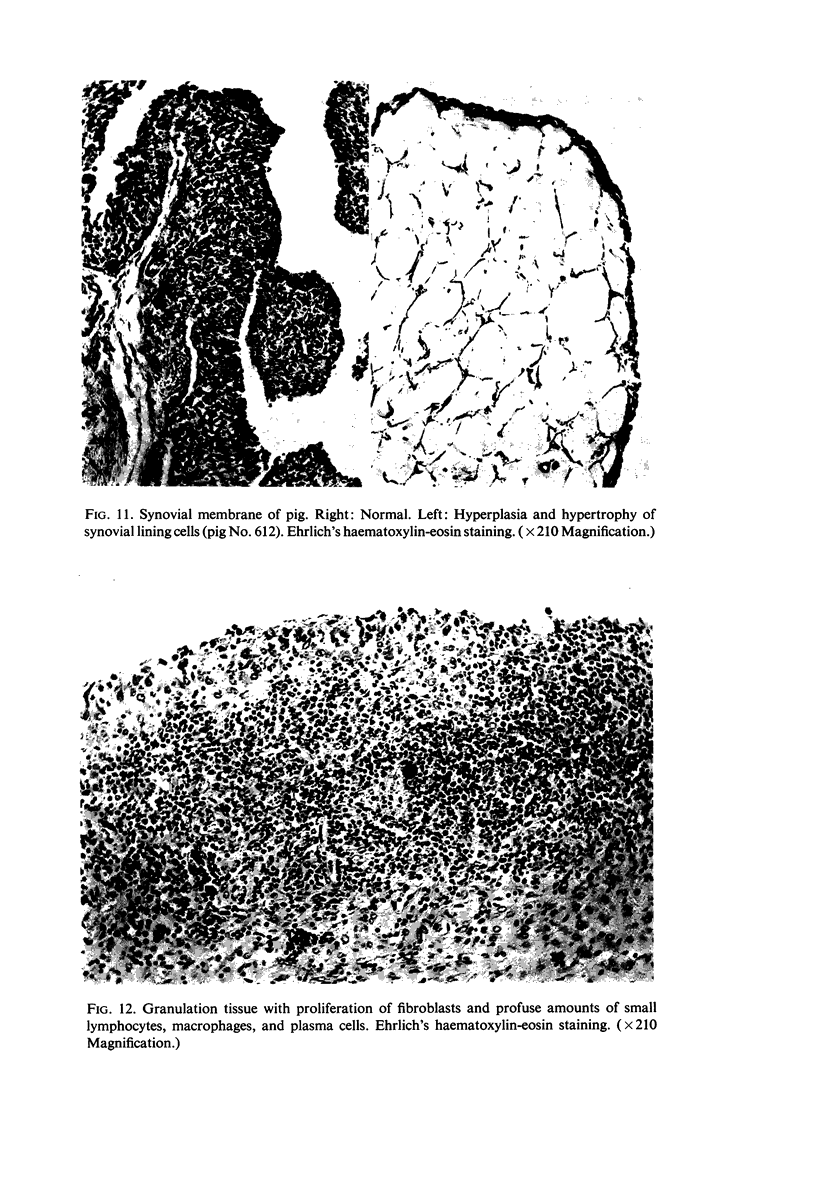Abstract
Eight-week-old pigs fed a protein-rich diet ad libitum developed an abnormal intestinal microbial flora within 1 week. The main feature was a significant increase in the number of atypical Clostridium perfringens, type A. In the first week after the change of diet, the pigs showed disturbances of movement and swollen peripheral joints. The ESR was concomitantly elevated and later on hypergammaglobulinaemia with increased antibody titres to Cl. perfringens antigens were noted. Joint deformities were observed after some months.
The joint lesions consisted of synovitis with a cell-rich exudate. The lesions of the synovial tissue were characterized by proliferation of the synovial lining cells with villous hypertrophy and highly vascularized granulation tissue containing accumulations of lymphoid cells. Pannus formation and erosion of joint cartilage were seen in some animals. Bacteriological examination, including search for mycoplasmas, was negative. Subcutaneous nodules of rheumatoid nature were also found. Signs of proliferative glomerulonephritis were demonstrated in most of the animals. Different pathogenic aspects are discussed with regard to the direct influence of Cl. perfringens antigens on the joint tissues, circulating antigen–antibody complexes and cell-bound antibodies. As the same abnormal intestinal flora and immunological reaction to intestinal Cl. perfringens have been found in human rheumatoid disease, this diet-induced pig arthritis of remarkably similar clinical and histological characteristics is of special interest.
Full text
PDF
















Images in this article
Selected References
These references are in PubMed. This may not be the complete list of references from this article.
- BERGLOEF F. E. ARTHRITIS AND INTESTINAL INFECTION. Acta Rheumatol Scand. 1963;9:141–149. doi: 10.3109/rhe1.1963.9.issue-1-4.18. [DOI] [PubMed] [Google Scholar]
- FREEMAN M. J., BERMAN D. T. HYPERSENSITIVITY IN ERYSIPELAS ARTHRITIS OF SWINE. II. HYPERSENSITIZATION OF SWINE WITH STERILE ERYSIPELOTHRIX ANTIGENS. Am J Vet Res. 1964 Jan;25:145–150. [PubMed] [Google Scholar]
- MANSSON I., SMITH L. D. Atypical strains of Clostridium perfringens from swine. Acta Pathol Microbiol Scand. 1962;55:342–348. doi: 10.1111/j.1699-0463.1962.tb04134.x. [DOI] [PubMed] [Google Scholar]
- Mansson I., Olhagen B. Intestinal Clostridium perfringens in arthritis and parakeratosis induced by dietary factors. Experimental studies in pigs. Bull Off Int Epizoot. 1967 Sep-Oct;67(9):1319–1328. [PubMed] [Google Scholar]
- Månsson I., Olhagen B. Intestinal Clostridium perfringens in rheumatoid arthritis and other connective tissue disorders. Studies of fecal flora, serum antitoxin levels and skin hypersensitivity. Acta Rheumatol Scand. 1966;12(3):167–174. doi: 10.3109/rhe1.1966.12.issue-1-4.20. [DOI] [PubMed] [Google Scholar]
- Månsson I. The intestinal flora in pigs with parakeratosis. V. Acta Vet Scand. 1965;6(3):261–267. doi: 10.1186/BF03547083. [DOI] [PMC free article] [PubMed] [Google Scholar]
- Olhagen B., Månsson I. Intestinal Clostridium perfringens in rheumatoid arthritis and other collagen diseases. Acta Med Scand. 1968 Nov;184(5):395–402. doi: 10.1111/j.0954-6820.1968.tb02478.x. [DOI] [PubMed] [Google Scholar]
- ZIFF M., BROWN P., LOSPALLUTO J., BADIN J., MCEWEN C. Agglutination and inhibition by serum globulin in the sensitized sheep cell agglutination reaction in rheumatoid arthritis. Am J Med. 1956 Apr;20(4):500–509. doi: 10.1016/0002-9343(56)90134-6. [DOI] [PubMed] [Google Scholar]






